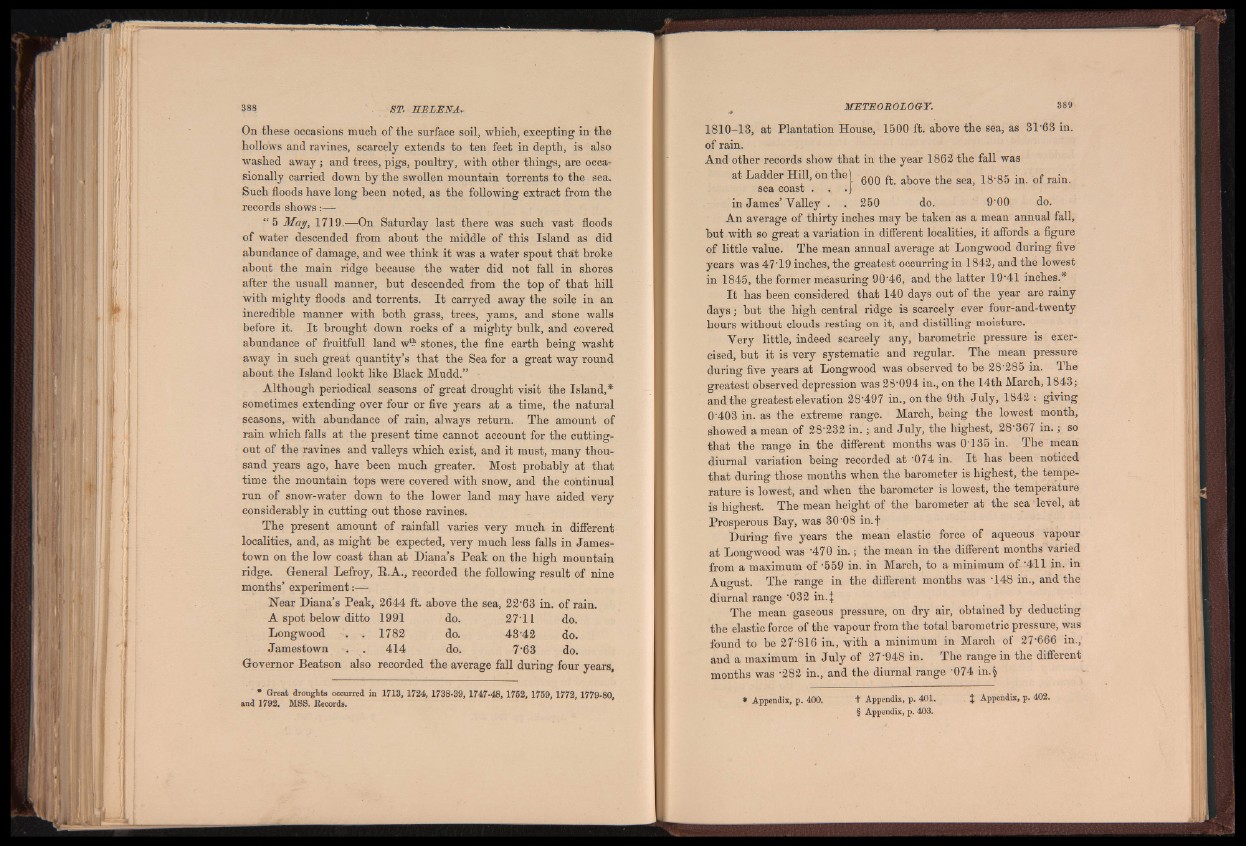
On these occasions much of the surface soil, which, excepting in the
hollows and ravines, scarcely extends to ten feet in depth, is also
washed away ; and trees, pigs, poultry, with other things, are occasionally
carried down hy the swollen mountain torrents to the sea.
Such floods have long heen noted, as the following extract from the
records shows:—
“ 5 May, 1719.—On Saturday last there was such vast floods
of water descended from ahout the middle of this Island as did
abundance of damage, and wee think it was a water spout that broke
about the main ridge because the water did not fall in shores
after the usuall manner, but descended from the top of that hill
with mighty floods and torrents. I t carryed away the soile in an
incredible manner with both grass, trees, yams, and stone walls
before it. I t brought down rocks of a mighty bulk, and covered
abundance of fruitfull land w* stones, the fine earth being washt
away in such great quantity’s that the Sea for a great way round
about the Island lookt like Black Mudd.” -
Although periodical seasons of great drought visit the Island,*
sometimes extending over four or five years at a time, the natural
seasons, with abundance of rain, always return. The amount of
rain which falls at the present time cannot account for the cutting-
out of the ravines and valleys which exist, and it must, many thousand
years ago, have heen much greater. Most probably at that
time the mountain tops were covered with snow, and the continual
run of snow-water down to the lower land may have aided very
considerably in cutting out those ravines.
The present amount of rainfall varies very much in different
localities, and, as might be expected, very much less falls in Jamestown
on the low coast than at Diana’s Peak on the high mountain
ridge. General Lefroy, R.A., recorded the following result of nine
months’ experiment:—
Near Diana’s Peak, 2644 ft. above the sea, 22*63 in. of rain.
A spot below ditto 1991 do. 27*11 do.
Longwood , 1782 do. 43*42 do.
Jamestown . . 414 do. 7*63 do.
Governor Beatson also recorded the average fall during four years.
* Great droughts occurred in 1713, 1724, 1738-39, 1747-48,1752, 1759, 1772,1779-8Q,
and 1792. MSS. Records.
1810-13, at Plantation House, 1500 ft. above the sea, as 31'63 in.
of rain.
And other records show that in the year 1862 the fall was
at Ladder Hill, on the) m ft M U the gea> 18.85 in of rain.
sea coast . .. .}
in James’ Valley . . 250 do. 9*00 do.
An average of thirty inches may be taken as a mean annual fall,
but with so great a variation in different localities, it affords a figure
of little value. The mean annual average at Longwood during five
years was 47T9 inches, the greatest occurring in 1842, and the lowest
in 1845, the former measuring 90*46, and the latter 19*41 inches.*
I t has been considered that 140 days out of the year are rainy
days; but the high central ridge is scarcely ever four-and-twenty
hours without clouds resting on it, and distilling moisture.
Very little, indeed scarcely any, barometric pressure is exercised,
but it is very systematic and regular. The mean pressure
during five years at Longwood was observed to he 28*285 in. Ih e
greatest observed depression was 28*094 in., on the 14th March, 1843;
and the greatest elevation 28*497 in., on the 9th July, 1842 : giving
0*403 in. as the extreme range. March, being the lowest month,
showed a mean of 28*232 in .; and July, the highest, 28*367 in .; so
that the range in the different months was 0*135 in. The mean
diurnal variation being recorded at *074 in. I t has been noticed
that during those months when the barometer is highest, the temperature
is lowest, and when the barometer is lowest, the temperature
is highest. The mean height of the barometer at the sea level, at
Prosperous Bay, was 30*08 in.f
During five years the mean elastic force of aqueous vapour
at Longwood was *470 in .; the mean in the different months varied
from a maximum of *559 in. in March, to a minimum of-*411 in. in
August. The range in the different months was *148 in., and the
diurnal range *032 in.J
The mean gaseous pressure, on dry air, obtained by deducting
the elastic force of the vapour from the total barometric pressure, was
found to be 27*816 in., with a minimum in March of 27*666 in.,
and a maximum in July of 27*948 in. The range in the different
months was *282 in., and the diurnal range *074 in.§
* Appendix, p. 400. t Appendix, p. 401. % Appendix, p. 402.
§ Appendix* p. 403.